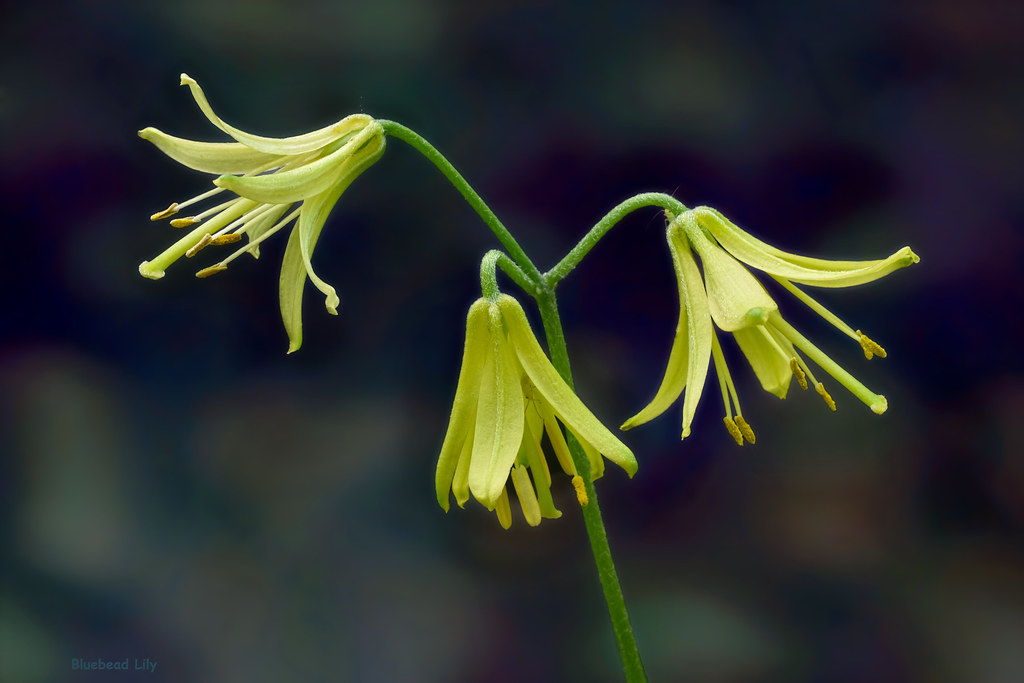A field guide on how to identify and propagate Bluebead (Clintonia borealis), a hardy zone 2 wildflower that is native to North America.
How to Identify Bluebead (Clintonia borealis)
Leaves

Bluebead leaves are oblong to elliptical-shaped, grow in a basal arrangement and have a ciliate to entire leaf margin (hairy to smooth).
Flowers

Bluebead flowers are yellow and have 6 petals that flare out and hang in clusters of three to eight.
Fruit

Bluebead fruits grow atop long stalks from 4-16 inches in height. Their striking blue color shows beautiful contrast with the forest floor. The berries may look tasty but are not edible.
Flowering Season
Clintonia borealis flowers bloom from May to July.
Habitat
Wet, evergreen forests & marshes; sometimes dry forests and woodlands; mountain pastures.
If you see the following plants, there’s a chance bluebead is growing nearby:
- Bunchberry (Cornus canadensis)
- Creeping Snowberry (Gaultheria hispidula)
- Labrador Tea (Rhododendron groenlandicum)
- Northern Starflower (Trientalis borealis)
Clintonia borealis is only found on the east side of North America.
Wildlife Value
Bluebead berries are eaten by chipmunks, squirrels, and birds.
The flowers attract pollinators such as bees and butterflies.
How to Propagate Bluebead (Clintonia borealis)


Hardiness Zone: 2-7

Soil Type: Acidic peat, loam, sand.

Water: Normal.

Exposure: Partial to Full Shade.
There are two effective ways to propagate bluebead (Clintonia borealis):
Each requires slightly different timing but can work quite well. Let’s go into the details:
How to Propagate Bluebead (Clintonia borealis) by Seed
Bluebead fruits appear mid to late summer, and they are ready to harvest for their seed in late summer to fall.
How to Harvest Seeds
They’re quite easy to spot, you can clip the blue fruits right off the stalks and bring them back home with you in a pocket or bag.
From there, let the fruit air dry for some weeks, this will make it easier to harvest the seeds inside.
Each berry seems to hold from 6-10 seeds.
Stratification
- Bag them in damp sand inside a ziplock bag, and tag the name and date.
- Warm-moist stratify them at room temperature for 60 days, then scarify them in room temperature water for 12 hours.
- Rebag them, and place them in the refrigerator for another 120 days.
You can skip this process if you simply plant them outside by the end of summer. That way they germinate the following spring.
If you’re growing them indoors, then after the stratification process, place them in a loamy soil mix under a fine layer of soil, moisten, and cover them with a wrap until germination occurs.
They will not germinate without stratification. Do not dry the seeds, always maintain moisture above 25%.
How to Propagate Bluebead (Clintonia borealis) by Division
Since bluebead spreads by rhizome, it’s possible to divide them into multiple plants. The best time to do this is when the plant is dormant in early Spring or Fall.

Here’s how to do it:
Rhizome are underground roots that spread horizontally where new clones sprout from, they look something like this:

1. You can separate two bluebead plants by severing their rhizome connection and transplanting them distanced from each other.
With this technique, you keep enough of the rhizome on each side that new clones could sprout from each new ‘mother’ plant.
2. Alternatively, you can snip pieces of rhizomes that are thick enough and get them to root and sprout without ‘mother’ plants.
Here’s how:
- First, dig around a mother plant to find the rhizomes.
- Next, carefully extract a long piece of rhizome, then snip it into thick pieces of 2-3 inches each.
- Place them in a container with peat moss or fresh green moss, and cover them with at least an inch of propagation medium.
- Moisten, and keep humid but never wet or soggy.
- Cover this container with a wrap and let the rhizomes wake.
- Finally, within a few weeks, you might see leaves come up through the propagation medium.
- Let them grow, and wait to transplant, new leaves don’t mean new roots.
It can take a whole year before the rhizomes have made sufficient new roots to survive a transplant.
FAQ
Q: Is Clintonia borealis poisonous?
A: Not really, the berries are only mildly toxic and foul-tasting, but the fresh leaves are edible in the spring.

